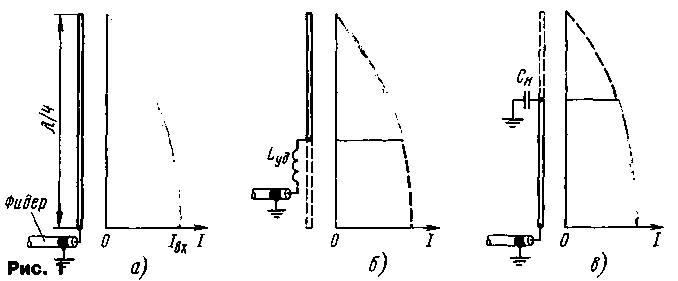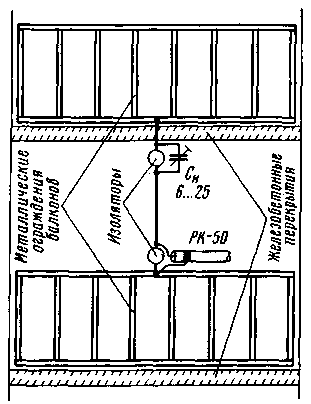
|
|
ENCYCLOPEDIA OF RADIO ELECTRONICS AND ELECTRICAL ENGINEERING balcony antennas. Encyclopedia of radio electronics and electrical engineering
Encyclopedia of radio electronics and electrical engineering / HF antennas Today, as in the early days of amateur radio, many radio amateurs are forced (for various reasons) to use "balcony" antennas. An interesting solution to the "balcony GP" is offered by the author of this article. As is known from the theory of antennas, in order to determine the intensity of the electromagnetic field created by a transmitting antenna, it is necessary to represent this antenna as a set of its segments - elementary radiators. At any receiving point, the field strength generated by the entire antenna is the sum of the field strength values generated by the emissions of each of these segments. In turn, the strength of the field created by a separate elementary emitter is proportional to the current passing through it and its length. In order to determine the current flowing through each elementary radiator, it is necessary to know the law of current distribution in the antenna, which depends on the type of antenna. The law of current distribution in a quarter-wave vibrator is shown in Fig. 1, a. It has a cosine character.
Of course, it is not possible to install a full-sized vertical quarter-wave vibrator for the 28 MHz amateur band or 27 MHz CB band on a balcony, not to mention a half-wave vibrator or a popular 5/8l vibrator. Therefore, shortened antennas are used as balcony antennas. In industrial antennas for mobile radios (and these are antennas with a length of less than a quarter of a wavelength), extension coils are used to compensate for the capacitive component of the input impedance. The current distribution in a shortened vertical vibrator with an extension coil is shown in Fig. 1b. In relation to the quarter-wave vibrator, the lower part of the antenna is, as it were, excluded in it, instead of which an inductance coil (extension coil) Lud is installed. Since the current in the lower part of the quarter-wave vibrator is maximum, then by shortening the antenna in this way, we exclude its most efficient part (the current distribution in which is shown in Fig. 1b by a dotted line). A fair question arises: is it possible to shorten the antenna so as to exclude not its lower part, but the upper one, in which the current is minimal? Such a method exists, and antennas of this type are widely used, for example, as transmitters on medium-wave radio stations. The antenna proposed in this article is exactly this type of antenna. In order to understand the principle of operation and the advantages of the proposed antenna, I would like to explain the principle of operation of such antennas in general. The upper part of a quarter-wave vibrator (Fig. 1a) can be represented as a separate vibrator, the length of which is less than a quarter of the wavelength. The input resistance of such a vibrator has a capacitive character. Therefore, with some assumptions, the upper part of the quarter-wave vibrator can be replaced by a load capacitor of the appropriate capacitance Cn. An antenna of this type, as well as the current distribution in it, are shown in Fig. 1c. As can be seen from the figure, the current distribution in this antenna is more favorable compared to the current distribution in a shortened antenna with an extension coil (Fig. 1b). In other words, with the same physical length of an antenna with an extension coil and an antenna with a capacitive load, the effective length (height) of the latter is greater. The absence of an extension coil in a capacitively loaded antenna is also an advantage. After all, in antennas where an extension coil is used, a significant proportion of losses falls on this particular coil. On fig. 2 shows an easy-to-make, but quite effective balcony antenna for the 28 MHz amateur band or the 27 MHz CBS band. A feature of its design is that the antenna does not protrude beyond the edges of the balcony, does not have an extension coil, and the metal parts of the balcony itself are used as counterweights. The antenna can be made on the balcony of a residential apartment, in which a metal structure (usually in the form of a welded grid) is used as the basis of the external fence (parapet). The metal railing of the balcony of your apartment may well perform the function of antenna counterweights, and the metal railing of the balcony above - the role of "ground" in the capacitive load circuit.
The braid of the coaxial cable is connected to the metal parapet (handrail) of the balcony. Capacitor Cn is connected by one terminal to the upper point of the antenna web, and by the other terminal - to the lower part of the metal parapet of the balcony of the upper floor. The capacitance of the capacitor Cn is selected with the length of the vibrator (antenna sheet) - 1,6 m. This usually corresponds to the height of the ceilings of a residential apartment of 2,5 m. If the length of the vibrator is different, then the capacitance Cn may differ from that indicated. The longer the length of the vibrator, the less capacitance Cn should be. The design of the antenna is shown in fig. 3. The antenna sheet is made of an antenna cord (the cross section is not critical). Several stranded insulated wires can be used. The ends of the wires must be stripped of insulation and soldered together. The insulators at the ends of the web are made in the form of plates made of textolite or other available insulating material. Trimmer capacitor Cn - ceramic disc type KPK-1. The lower antenna insulator is attached to the fence with two bolts, which, in addition, by means of terminals, must ensure reliable electrical contact between the cable sheath and the metal balcony parapet. It is also necessary to drill a mounting hole in the lower part of the parapet of the balcony above. A bolt is also screwed into this hole, which, for reliable contact, must firmly clamp the terminal to which the wire connected to the rotor of the tuning capacitor Cn should be soldered in advance.
The antenna is tuned using an SWR meter. By adjusting the trimmer capacitor Cn, a minimum SWR is achieved in the middle of the operating range. To avoid precipitation on the tuning capacitor, after tuning, put on a plastic bag on the board with the capacitor, which should then be tightly wound to the wire going from this board to the upper balcony. The bottom edge of the bag must be free - this will prevent the formation of condensate inside the bag and will not allow moisture to accumulate there. It should be noted that the proposed antenna is not suitable for operation with a power amplifier. Firstly, in this antenna, as in a quarter-wave vibrator, the voltage at the upper end of the vibrator is several times higher than the voltage supplied to the antenna by the feeder (at the lower point of the vibrator). Therefore, if the input power exceeds about 20 W, the tuning capacitor Cn can be broken, and if moisture gets in, breakdown can occur even at a lower power. Secondly, with a large input power, rather large RF voltages can be present on the metal railings of the balconies. (Up to 20 watts, these voltages can't cause any trouble.) However, when using other balcony antennas, it is not recommended to work with high powers for sanitary and hygienic reasons. Without any changes in the design (only a capacitor adjustment is required), the antenna works fine in the 27 MHz (CB) band. In my opinion, a shortened antenna with a capacitive load is just perfect for the balcony of a residential apartment. Particularly good results when working on a balcony antenna are obtained if the radio station is located on one of the upper floors of a multi-storey building, and also if the direction to the correspondent lies within a semicircle bounded by the wall of the house from the side of the balcony (± 90 ° from the perpendicular direction to the wall). Literature
Publication: N. Bolshakov, rf.atnn.ru
Machine for thinning flowers in gardens
02.05.2024 Advanced Infrared Microscope
02.05.2024 Air trap for insects
01.05.2024
▪ Contact lenses that project information into the eyes ▪ Wireless charging of electric vehicles on the go ▪ Bus stops with solar panels and air conditioning ▪ New Kingmax memory cards record 4K2K video
▪ site section And then an inventor (TRIZ) appeared. Article selection ▪ article by George Eliot (Mary Ann Evans). Famous aphorisms ▪ Dead Sea article. Nature miracle
Home page | Library | Articles | Website map | Site Reviews www.diagram.com.ua |






 Arabic
Arabic Bengali
Bengali Chinese
Chinese English
English French
French German
German Hebrew
Hebrew Hindi
Hindi Italian
Italian Japanese
Japanese Korean
Korean Malay
Malay Polish
Polish Portuguese
Portuguese Spanish
Spanish Turkish
Turkish Ukrainian
Ukrainian Vietnamese
Vietnamese



 Leave your comment on this article:
Leave your comment on this article: